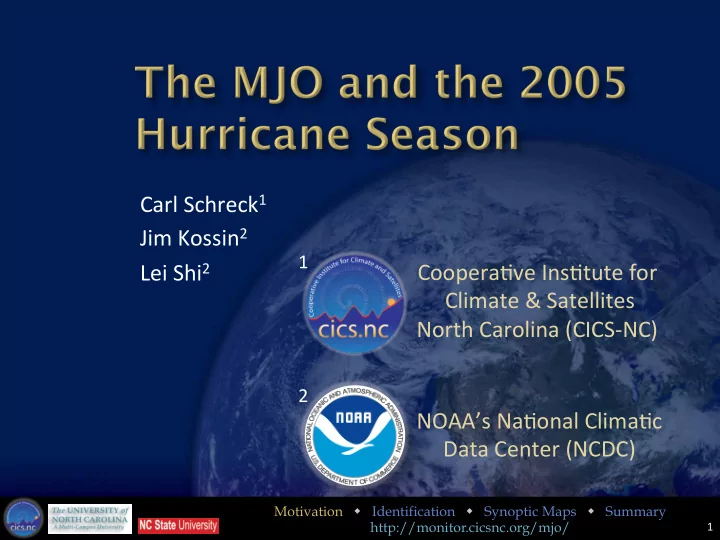

Carl ¡Schreck 1 ¡ Jim ¡Kossin 2 ¡ 1 ¡ Lei ¡Shi 2 ¡ Coopera6ve ¡Ins6tute ¡for ¡ ¡Climate ¡& ¡Satellites ¡ North ¡Carolina ¡(CICS-‑NC) ¡ 2 ¡ NOAA’s ¡Na6onal ¡Clima6c ¡ ¡ Data ¡Center ¡(NCDC) ¡ Motivation w Identification w Synoptic Maps w Summary 1 ¡ http://monitor.cicsnc.org/mjo/
MJO ¡was ¡ac6ve ¡during ¡the ¡2005 ¡Hurricane ¡Season ¡ • ¡ Wheeler–Hendon ¡RMM ¡shows ¡weak, ¡disorganized ¡signal ¡ ¡ Velocity ¡poten6al ¡and ¡Water ¡Vapor ¡iden6fy ¡clear ¡eastward ¡propaga6ng ¡signal ¡ MJO ¡influenced ¡hurricane ¡ac6vity ¡in ¡the ¡eastern ¡Pacific ¡and ¡the ¡Atlan6c ¡ • ¡ Par6cularly ¡in ¡the ¡eastern ¡Pacific ¡or ¡equatorward ¡of ¡20°N ¡ MJO ¡modulated ¡key ¡factors ¡that ¡determine ¡tropical ¡cyclone ¡ac6vity ¡ • ¡ Convec6on ¡ ¡ Moisture ¡ ¡ Shear ¡ ¡ Low-‑level ¡westerlies ¡ Monitoring ¡for ¡future ¡events ¡ • ¡ hXp://monitor.cicsnc.org/mjo/ ¡ Motivation w Identification w Synoptic Maps w Summary 2 ¡ http://monitor.cicsnc.org/mjo/
1 2 Based ¡on ¡the ¡RMM ¡ • Index ¡for ¡May–June ¡ 3 Each ¡phase ¡is ¡≈6 ¡ • 4 days ¡apart ¡ 5 Eastern ¡Hemisphere ¡ • dominates ¡ 6 Weaker ¡signal ¡in ¡ • eastern ¡North ¡Pacific ¡ 7 ¡ But ¡important ¡for ¡ 8 hurricanes! ¡ ¡ Anomalies of rainfall (shading) and surface winds (CLIVAR MJO Working Group 2009, J. Climate) Motivation w Identification w Synoptic Maps w Summary 3 ¡ http://monitor.cicsnc.org/mjo/
Strongest ¡signals: ¡ • Fewer Storms � ¡ Eastern ¡Pacific ¡ ¡ Gulf ¡of ¡Mexico ¡ ¡ MDR? ¡ Likely ¡mechanisms: ¡ • No Signal � ¡ Ver6cal ¡Wind ¡Shear ¡ More Storms � ¡ Moisture ¡ ¡ Easterly ¡Wave ¡ac6vity ¡ Motivation w Identification w Synoptic Maps w Summary 4 ¡ http://monitor.cicsnc.org/mjo/
RMM ¡Signal ¡was ¡ • Fewer Storms � weak ¡and ¡ disorganized ¡ Suggests ¡minimal ¡ • influence ¡on ¡Atlan6c ¡ TCs ¡ No Signal � More Storms � Motivation w Identification w Synoptic Maps w Summary 5 ¡ http://monitor.cicsnc.org/mjo/
Another ¡common ¡ • diagnos6c ¡for ¡the ¡ MJO ¡ ¡ Nega6ve ¡values ¡ indicate ¡upper ¡level ¡ ouhlow ¡ Clear ¡eastward ¡ • propaga6on ¡ ¡ Period ¡≈ ¡40 ¡Days ¡ ¡ Phase ¡Speed ¡≈ ¡10 ¡m/s ¡ Data from the NCEP-DOE Reanalysis 2 Motivation w Identification w Synoptic Maps w Summary 6 ¡ http://monitor.cicsnc.org/mjo/
Genesis ¡points ¡move ¡ • eastward ¡with ¡MJO ¡ Strongest ¡signals ¡ ¡ • ¡ Eastern ¡Pacific ¡ ¡ Equatorward ¡of ¡20°N ¡ △ Genesis north of 20°N ▽ Genesis south of 20°N Motivation w Identification w Synoptic Maps w Summary 7 ¡ http://monitor.cicsnc.org/mjo/
Enhanced ¡convec6on ¡and ¡enhanced ¡moisture ¡in ¡far ¡ • eastern ¡Pacific ¡ Amplified ¡trade ¡easterlies ¡over ¡eastern ¡Pacific ¡ • No ¡storms ¡around ¡Central ¡America ¡within ¡suppressed ¡ • convec6on ¡ ¡ Motivation w Identification w Synoptic Maps w Summary 8 ¡ http://monitor.cicsnc.org/mjo/
Enhanced ¡convec6on ¡and ¡moisture ¡spread ¡ • eastward ¡ Westerly ¡anomalies ¡develop ¡over ¡eastern ¡Pacific ¡ • Shear ¡begins ¡to ¡increase ¡over ¡eastern ¡Pacific ¡ • Motivation w Identification w Synoptic Maps w Summary 9 ¡ http://monitor.cicsnc.org/mjo/
Enhanced ¡convec6on ¡and ¡moisture ¡around ¡Central ¡ • America ¡ Westerly ¡anomalies ¡intensify ¡over ¡eastern ¡Pacific ¡ • Strengthening ¡shear ¡pushes ¡eastern ¡Pacific ¡storms ¡closer ¡ • to ¡the ¡Mexican ¡coast ¡ Katrina ¡forms ¡on ¡Eastern ¡edge ¡of ¡moist ¡envelope ¡ • Motivation w Identification w Synoptic Maps w Summary 10 ¡ http://monitor.cicsnc.org/mjo/
Moisture ¡and ¡westerly ¡anomalies ¡move ¡ • northeastward ¡into ¡Atlan6c ¡ Dry ¡anomalies ¡extend ¡from ¡equatorial ¡eastern ¡Pacific ¡ • to ¡North ¡America ¡ ¡ No ¡genesis ¡in ¡eastern ¡Pacific, ¡Gulf, ¡or ¡Caribbean ¡ Motivation w Identification w Synoptic Maps w Summary 11 ¡ http://monitor.cicsnc.org/mjo/
Convec6on ¡and ¡easterly ¡anomalies ¡return ¡to ¡eastern ¡ • Pacific ¡ Shear ¡has ¡weakened ¡over ¡the ¡eastern ¡Pacific ¡ • Only ¡genesis ¡in ¡Atlan6c ¡is ¡Ophelia ¡at ¡the ¡beginning ¡of ¡ • the ¡period ¡(6-‑Sep) ¡ Motivation w Identification w Synoptic Maps w Summary 12 ¡ http://monitor.cicsnc.org/mjo/
Westerly ¡anomalies ¡develop ¡as ¡convec6on ¡moves ¡ • eastward ¡ Rita ¡develops ¡within ¡weak ¡envelope ¡of ¡moisture ¡ • Shear ¡intensifies ¡over ¡both ¡basins ¡ • Water ¡vapor ¡suggests ¡a ¡connec6on ¡to ¡the ¡Southern ¡ • Hemisphere ¡ Motivation w Identification w Synoptic Maps w Summary 13 ¡ http://monitor.cicsnc.org/mjo/
Upper ¡divergence ¡moves ¡to ¡eastern ¡Atlan6c ¡ • Anomalous ¡westerlies ¡and ¡moisture ¡straddle ¡ • Central ¡America ¡ Shear ¡has ¡strengthened ¡over ¡both ¡basins ¡ • Motivation w Identification w Synoptic Maps w Summary 14 ¡ http://monitor.cicsnc.org/mjo/
Westerlies ¡strengthen ¡ ¡as ¡upper ¡divergence ¡ • extends ¡back ¡into ¡western ¡Atlan6c ¡ Wilma ¡develops ¡within ¡envelope ¡of ¡enhanced ¡ • moisture ¡ Motivation w Identification w Synoptic Maps w Summary 15 ¡ http://monitor.cicsnc.org/mjo/
• Examine ¡precipitable ¡water ¡using ¡SSMIS ¡data ¡ • Develop ¡a ¡real-‑6me ¡MJO ¡index ¡for ¡the ¡Western ¡ Hemisphere ¡ • Construct ¡a ¡climatology ¡of ¡these ¡events ¡ Motivation w Identification w Synoptic Maps w Summary 16 ¡ http://monitor.cicsnc.org/mjo/
MJO ¡was ¡ac6ve ¡during ¡the ¡2005 ¡Hurricane ¡Season ¡ • ¡ Wheeler–Hendon ¡RMM ¡shows ¡weak, ¡disorganized ¡signal ¡ ¡ Velocity ¡poten6al ¡and ¡Water ¡Vapor ¡iden6fy ¡clear ¡eastward ¡propaga6ng ¡signal ¡ MJO ¡influenced ¡hurricane ¡ac6vity ¡in ¡the ¡eastern ¡Pacific ¡and ¡the ¡Atlan6c ¡ • ¡ Par6cularly ¡in ¡the ¡eastern ¡Pacific ¡or ¡equatorward ¡of ¡20°N ¡ MJO ¡modulated ¡key ¡factors ¡that ¡determine ¡tropical ¡cyclone ¡ac6vity ¡ • ¡ Convec6on ¡ ¡ Moisture ¡ ¡ Shear ¡ ¡ Low-‑level ¡westerlies ¡ Monitoring ¡for ¡future ¡events ¡ • ¡ hXp://monitor.cicsnc.org/mjo/ ¡ Motivation w Identification w Synoptic Maps w Summary 17 ¡ http://monitor.cicsnc.org/mjo/
18 ¡
19 ¡
20 ¡
21 ¡
22 ¡
23 ¡
Recommend
More recommend